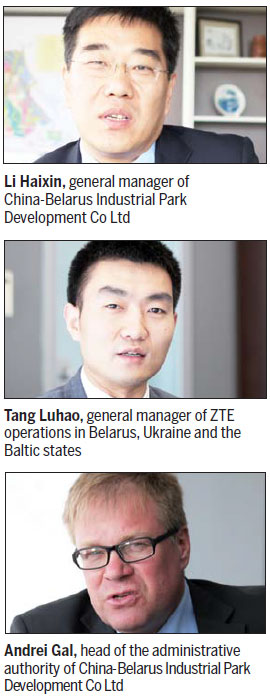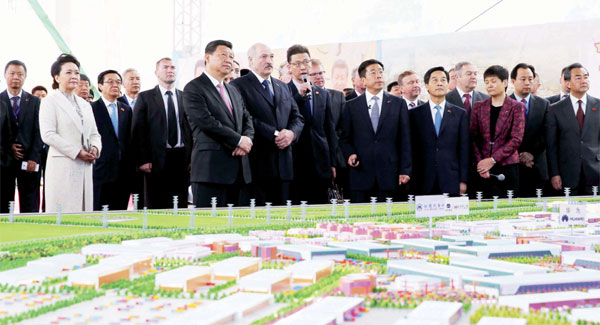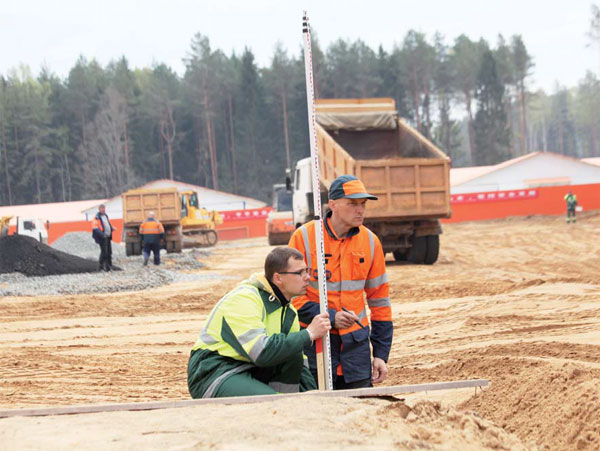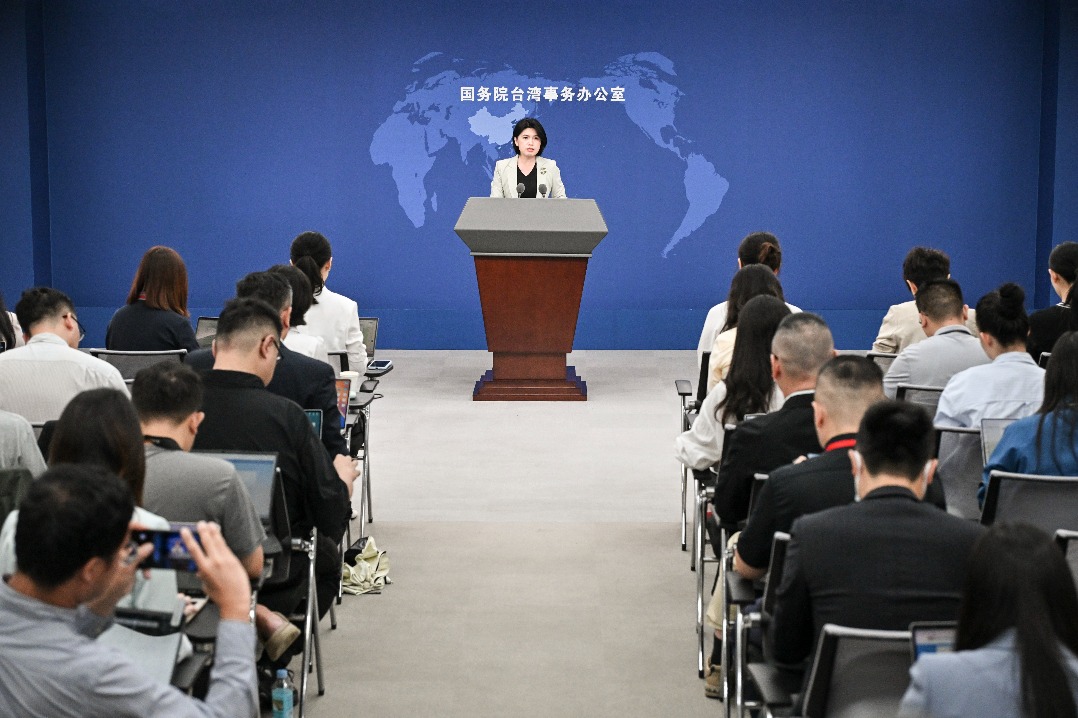China helps build Belarus boomtown

Massive high-tech industrial park and future home for 200,000 near Minsk draws Chinese firms and dovetails with One Belt, One Road initiative
Just next to Minsk's airport in the suburbs of Belarus' capital, more than 300 construction workers from China and Belarus have been busy cutting a wide road through 3.5 square kilometers of forest. They are also installing pipes for gas, electricity and water. The workers are in the first steps of turning this area, which is blessed with geographical advantages, into a core industrial sector of a Minsk high-tech satellite city designed to host 200,000 people within 20 years. The rough idea is to repeat China's development pattern in recent decades.
Less than 40 years ago, when China started its reform and opening-up strategy after decades of a planned economy, late architect of reform Deng Xiaoping chose a fishing village near Hong Kong as a pioneering site. This village has grown into the world-renowned boomtown of Shenzhen.
| Chinese President Xi Jinping and his wife, Peng Liyuan, with Belarusian President Alexander Lukashenko during the visit to the China-Belarus Industrial Park in Minsk on May 12. Ju Peng / Xinhua |
| More than 300 workers from China and Belarus are working against the clock at the industrial park, which is ready to host investors at the end of 2016. Fu Jing / China Daily |
In the case of Belarus, the village is Great Stone, near Minsk's airport. Following a request from Belarus, the two countries have worked together to turn the remote, 90-square-kilometer area around this village into a high-tech industrial zone. Only about 2,000 people now live in this picturesque area, located along the Moscow-Berlin economic corridor, giving it great geopolitical significance.
"We have started a great mission, which may last decades, to realize the miracle that China has realized in previous decades," says Li Haixin, general manager of China-Belarus Industrial Park Development Co Ltd, in an interview with China Daily.
His company is responsible for road, network and other infrastructure construction for the China-Belarus Industrial Park. "This new eco- and high-tech satellite, upon its completion, will be bigger than central Beijing, which is amazing," Li says.
Chinese President Xi Jinping visited the construction site with his Belarusian counterpart Alexander Lukashenko as part of the last leg of his three-country visit on May 7-12.
Xi called the project a "pearl" in the string of the One Belt, One Road initiative he proposed in 2013 to connect Asia to Europe, Africa and the Middle East. The Silk Road Economic Belt and 21st Century Maritime Silk Road are based on a series of trade and infrastructure proposals and are inspired by historic Silk Road trading routes. In April, when Xi visited Pakistan, the initiative started to take shape in the form of multi-billion-dollar agreements.
During Xi's visit to Belarus, eight Chinese provinces set up business connections with seven of that country's regions. China's central bank says that on May 11 it signed a currency swap agreement, valued at 7 billion yuan ($1.15 billion; 1.01 billion euros), with the Belarus central bank.
The three-year agreement can be extended subject to agreement by both sides. It is designed to facilitate trade and investment as well as boost economic development on both sides.
"My understanding is that this project, located at the gateway to Asia and Europe, is an example for China to further open to the rest of the world," Li says. "This is a gateway to the European Union."

The zone is focused on high-end manufacturing, chemicals, electronics and information, new materials, biotech engineering and logistics. It will be open to investors from around the world and offer preferential policies such as tax breaks and one-stop registration services.
"We will be ready to let the first group of companies move in by the end of next year," Li says.
Six Chinese companies had signed agreements to move into the China-Belarus Industrial Park and nine had expressed their intent to do so by press time. Russian and German investors also had shown an interest.
The park is to be completed in two phases, Li says. It is expected to take eight to 10 years to finish the first phase, which covers 8.5 square kilometers. The second is expected to take at least 20 years. The construction work that started last year has focused on the core area of 3.5 square kilometers.
"It is a long-term project. Upon its completion, it will be a new city in the forest, which is picturesque," Li says. "We hope it will hold more than 200,000 residents, which will be a big job creator for Belarus."
Belarus is fully behind construction of the park, Li says. In the past three years, Lukashenko has issued two presidential decrees to lay the legal foundation for the park and its investors.
The land would be leased for 99 years without charge and investors would be given tax-free benefits during the first 10 years. In the second 10 years, the government would levy only half of the normal taxes.
"This is attractive, and every day I talk with interested investors," Li says.
Apart from the proximity of the airport and the Berlin-Moscow highway, it is linked by rail to China and the rest of Europe, and it is some 300-400 km from the Baltic Sea.
Li says Belarus is keen to learn from China's experiences and the authorities have offered several options of locations, though it has already set up five trade and investment zones to attract foreign investment.
Lukashenko calls China-Belarus Industrial Park the country's most important joint project. "China has made tremendous changes and has become a world leader in many fronts," Lukashenko said, according to The Minsk Times. "We need to learn."
Given its position at the center, Belarus will offer Chinese investors a bridge to the heart of the European market, Lukashenko says.
Apart from the Chinese companies that already have plans to move in or intend to do so, more than 30 companies from China and Belarus have been negotiating contracts, according to Andrei Gal, head of the park's administrative authority. Authorities have set the minimum investment at $5 million (4.4 million euros) for each investor.
Gal says some companies are much more ambitious. China Merchants Group plans to invest $500 million in the park, he says. The group is a state-owned enterprise that is a major shareholder in China Merchants Bank and other businesses.
"In addition, China Merchants Group has plans to buy 20 percent of the capital stock in the joint managerial company of the park to be able to participate in the decision-making, management and development of the park," says Gal.
Talks also have been held with Chinese telecommunications giants ZTE and Huawei, the China National Machinery Industry Corp (known as Sinomach), construction equipment maker Zoomlion Heavy Industry Science & Technology Development, and YTO Group Corp, a maker of tractors and related equipment.
"We may finalize our investment plan in a few days and, together with our German partner, we are going to lease land and construct a factory in June in the park to localize our manufacturing," says Tang Luhao, general manager of ZTE operations in Belarus, Ukraine and the Baltic states.
"We are progressing very fast right now and many experts are busy with our detailed investment plan in the park," says Tang, adding that the connection with the Silk Road initiative presents opportunities for his company.
He says ZTE could benefit from convenient financing from China, and tax breaks and other advantages offered by Belarus for moving into the park.
"This will help us localize production on a bigger scale, which will create more jobs for Belarus; and in return, we can gain greater market access in the Customs Union of Belarus, Kazakhstan and Russia," Tang says.
ZTE has won the right to be the telecommunications infrastructure provider for the park. "So far, there is no competitor," says Tang, adding that his company obtained the designation when Belarusian leaders visited China in 2013 and 2014.
The manufacturing base in Belarus should help ZTE better connect with Europe, he says. "In doing so, we can help integrate our production and marketing in this region and the European Union," Tang says, including the company's production center in Hungary.
Liu Jia in Brussels contributed to the story.
fujing@chinadaily.com.cn
(China Daily European Weekly 05/15/2015 page16)
Today's Top News
- Tajikistan looks to China for deeper ties
- High-tech manufacturing lifts industrial profits
- Avenue blooms with flowers to mark victory
- Mainland slams DPP for distorting WWII history
- Northeast Asia trade in focus at Jilin expo
- Organic agriculture forum unites global experts in Datong
































